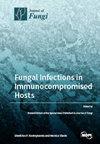真菌感染中的性别偏见新概览
IF 4.2
2区 生物学
Q2 MICROBIOLOGY
引用次数: 0
摘要
真菌感染对男性的影响往往超过女性。自美国国立卫生研究院于2016年规定研究人员必须在生物性别中测试他们的假设以来,已经发现许多其他真菌感染/定植表现出性别特异性模式。在小鼠、果蝇、猫和蝙蝠等不同物种中都观察到了这些模式,这对理解这些疾病和开发治疗方法具有重要意义。尽管人们认识到了这种性别偏见,但解释其根本原因或机制的初步研究仍然有限。目前的证据表明,潜在的原因可能与性激素、基因表达和进化行为有关。本综述整合了不同物种真菌感染或定植中性别偏向的最新数据,并针对现有差距提出了未来的研究方向。因此,本综述有助于人们理解生物性别、真菌感染和更广泛的健康影响之间错综复杂的关系。本文章由计算机程序翻译,如有差异,请以英文原文为准。
A New Overview of Sex Bias in Fungal Infections
Fungal infections often disproportionately affect males over females. Since the NIH mandated in 2016 that researchers test their hypotheses in both biological sexes, numerous other fungal infections/colonizations have been found to exhibit sex-specific patterns. These patterns have been observed in various species, including mice, drosophila, cats, and bats, suggesting significant implications for understanding these diseases and developing treatments. Despite the recognition of this sex bias, primary research explaining its underlying causes or mechanisms remains limited. Current evidence suggests that potential causes might be linked to sex hormones, genetic expression, and evolutionary behaviors. This review consolidates recent data on sex bias in fungal infections or colonizations among different species and proposes future research directions to address existing gaps. Thus, this review advances the comprehension of the intricate relationships between biological sex, fungal infections, and broader health implications.
求助全文
通过发布文献求助,成功后即可免费获取论文全文。
去求助
来源期刊

Journal of Fungi
Medicine-Microbiology (medical)
CiteScore
6.70
自引率
14.90%
发文量
1151
审稿时长
11 weeks
期刊介绍:
Journal of Fungi (ISSN 2309-608X) is an international, peer-reviewed scientific open access journal that provides an advanced forum for studies related to pathogenic fungi, fungal biology, and all other aspects of fungal research. The journal publishes reviews, regular research papers, and communications in quarterly issues. Our aim is to encourage scientists to publish their experimental and theoretical results in as much detail as possible. Therefore, there is no restriction on paper length. Full experimental details must be provided so that the results can be reproduced.
 求助内容:
求助内容: 应助结果提醒方式:
应助结果提醒方式:


